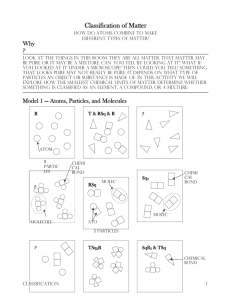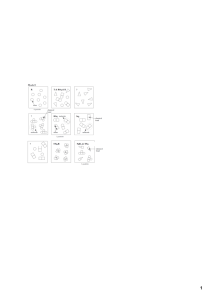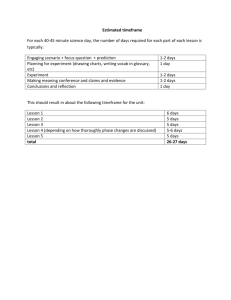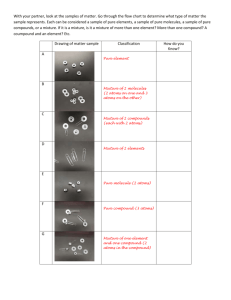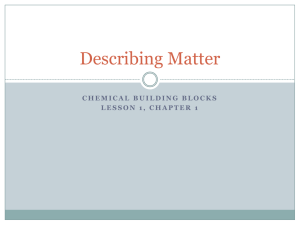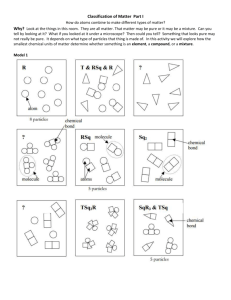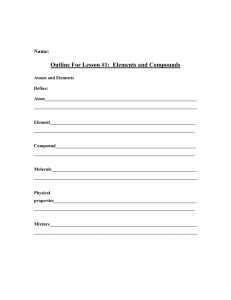File
advertisement
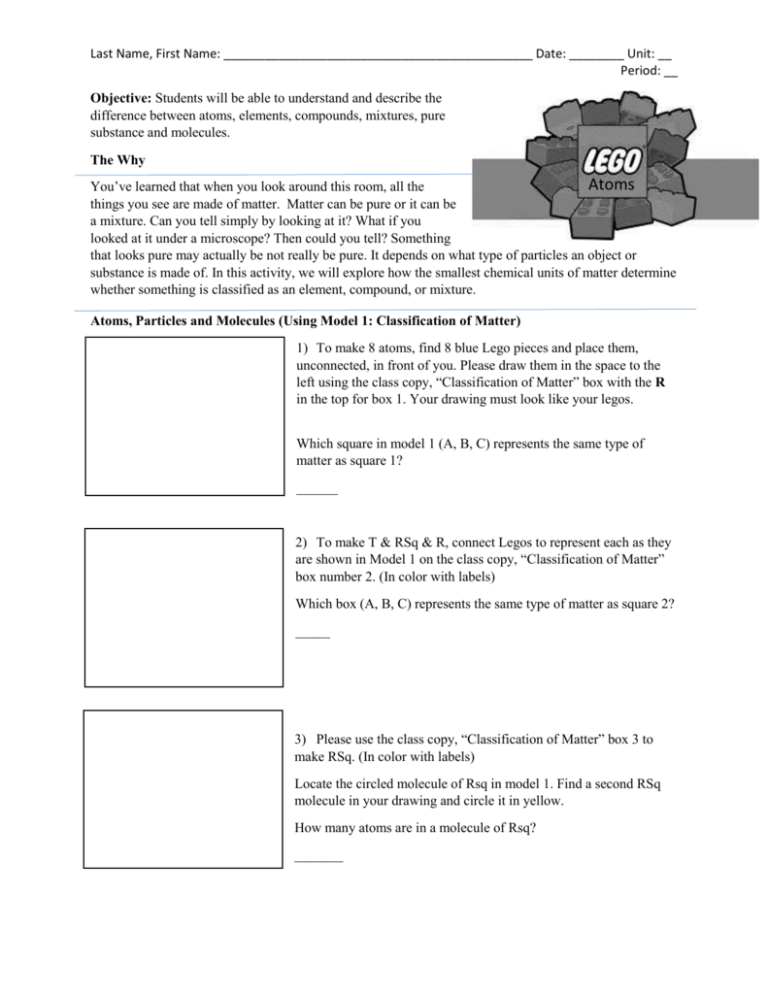
Last Name, First Name: _____________________________________________ Date: ________ Unit: __ Period: __ Objective: Students will be able to understand and describe the difference between atoms, elements, compounds, mixtures, pure substance and molecules. The Why Atoms You’ve learned that when you look around this room, all the things you see are made of matter. Matter can be pure or it can be a mixture. Can you tell simply by looking at it? What if you looked at it under a microscope? Then could you tell? Something that looks pure may actually be not really be pure. It depends on what type of particles an object or substance is made of. In this activity, we will explore how the smallest chemical units of matter determine whether something is classified as an element, compound, or mixture. Atoms, Particles and Molecules (Using Model 1: Classification of Matter) 1) To make 8 atoms, find 8 blue Lego pieces and place them, unconnected, in front of you. Please draw them in the space to the left using the class copy, “Classification of Matter” box with the R in the top for box 1. Your drawing must look like your legos. Which square in model 1 (A, B, C) represents the same type of matter as square 1? ______ 2) To make T & RSq & R, connect Legos to represent each as they are shown in Model 1 on the class copy, “Classification of Matter” box number 2. (In color with labels) Which box (A, B, C) represents the same type of matter as square 2? _____ 3) Please use the class copy, “Classification of Matter” box 3 to make RSq. (In color with labels) Locate the circled molecule of Rsq in model 1. Find a second RSq molecule in your drawing and circle it in yellow. How many atoms are in a molecule of Rsq? _______ 4) Please use the class copy to make Sq2 with your Legos. Please draw in the space provided in color with labels. 5) Please use the class copy to complete TSq2R. Please draw it in the space provided in color with labels. How many different types of atoms are found in a molecule of TSq2R? ______ How many Sq atoms are found in a molecule of TSq2R? _______ 6) Please use the class copy to complete SqR3 & TSq. Please draw in the space provided in color with labels. How many different types of atoms are found in the sample of SqR3 & TSq? _____ How many different types of molecules are found in the sample of SqR3 & TSq? ______ 7) a. From your lego models…When two atoms are touching, what is holding the atoms together? _________________ b. How is this represented in your lego models? ______________________________________________ 9) Can a particle be a single atom? ________________________________________________________ 10) Can a particle be a molecule? _________________________________________________________ 11) How many particles are in the drawing representing T & RSq & R in model 1? __________________ 12) What is your group’s definition of the word particle as it is used in chemistry? 13) Compare the codes listed at the top of each drawing in Model 1 with the shapes in that box. a. What do the letters R, Sq and T in the codes represent? b. What do the small numbers (subscripts) in the codes represent? c. When atoms are touching how is that communicated in the code (Hint: how is the code different when two atoms are touching compared to when they aren’t?) d. What is the common characteristic of the samples in which an ampersand (&) is used? 14) In model 1, there are 3 drawings that are labeled with the letters (A, B, C). Write codes to properly label these drawings. 15) Use the sort (Classification of Matter Model 1) to sort the drawings into two categories. One where all the particles in the drawing are identical, and a second where the drawings contain more than one type of particle. When you’re finished, have your teacher check and initial in the space below. Teacher Initials: _____ Read This! Matter is classified as a pure substance when all of the particles are identical. Matter is classified as a mixture if there are different types of particles present. 16. Identify which drawings from question 15 are pure substances and which are mixtures. List the codes for the drawings below: Pure Substances Mixtures _______________ ________________ ________________ _______________ ________________ ________________ _______________ ________________ ________________ 17. How are the codes (chemical formulas) for pure substances different from those for mixtures? 18. As a team, take the set of pure substance drawings from question 8 from the sort and sort them into new groups, those containing only one type of atom and those with two or more types of atoms. Read This! Elements are defined as pure substances made only from one type of atom. Compounds are defined as pure substances made from two or more types of atoms. 19. Identify which drawings from question 18 are elements and which are compounds. List the codes (chemical formulas) for the drawings in the category below. Elements Compounds ______________ _______________ ______________ _______________ ______________ _______________ 20. How are the codes (chemical formulas) for elements different from those for compounds? 21. Use what you have just learned about chemical formulas to identify each of the following as an element, compound, or mixture: a. Br2 b. NaHCO3 c. C6H12O6 & H2O d. Cu & Zn e. CO2 f. Al 22. Explain the difference between: a. An atom and an element. b. A molecule and a compound. 23. It is often useful to separate matter. Physical methods of separation (filtering, distillation) do not require a chemical change. In other words, no chemical bonds are broken or formed during the separation. Chemical methods of separation (decomposition, electrolysis) require a chemical change. In other words, chemical bonds are broken and/or formed during the separation. a. Is straining pasta from water a chemical or physical change? b. Is using a fuel cell to separate water into hydrogen and oxygen a physical or chemical separation? c. Which type(s) of matter (mixtures/compounds/elements) could be separated by: i. Physical methods: ii. Chemical methods:

